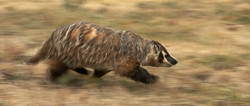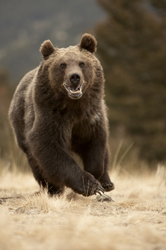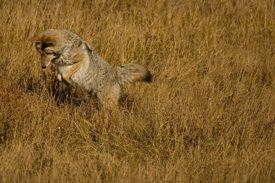

Mary and I just returned from nearly five weeks of travel out west - to Monterrey, California for sea otters and shorebirds, and to Animals of Montana for a wildlife model shoot (we did two), and to Yellowstone for two fall photo tours. In all, we did a lot of action photography, most of it in the great company of other photographers, and the question often came up, how do we shoot action.



We shoot manual mode/spot metering because with spot metering we can precisely meter where we wish, and with manual mode our aperture and shutter speed settings are fixed unless or until we change them. Therefore, if the background changes, going from dark to light, for example, our exposure on the subject would not change if we set that exposure for the subject. In this way, we insure a consistently accurate exposure.
 This
seems like a slow process for beginners but it actually is not,
and we are deadly accurate in this mode.
This
seems like a slow process for beginners but it actually is not,
and we are deadly accurate in this mode.
We also have our motor drives set for CONTINUOUS HIGH, the fastest frame rate possible, which with our 1D cameras is 8 fps. In this way, I'm not worried about missing action or fleeting expressions. We also set our auto-focus on SERVO, rather than One Shot, so that the camera fires even if the subject isn't in focus. That might not sound right, but in One Shot the camera will not focus smoothly and continuously on moving subjects, but will on Servo.
We also use Custom Function 4-1, which dissociates the shutter button from the AF function. Depressing the shutter button activates the meter, and fires the camera of course, but the focus isn't activated. To focus, we use the star button in back, which our thumbs depress. To continually follow a subject, simply hold in this button with your thumb. Nikon cameras also have this function, but it is no longer 4-1, as it was with our old film cameras.
If I'm really worried about following action I use the center focusing point of my 45 point AF system, although only 11 AF points are normally activated. Mary often uses all 45 points for acquiring focus, and here we differ, but the center focusing point is the fastest for following action.
As you can see by some of these examples, we're doing OK in
capturing action with this system!
.
|
|
|
|
Flash-Remotes |
|
NANPA |